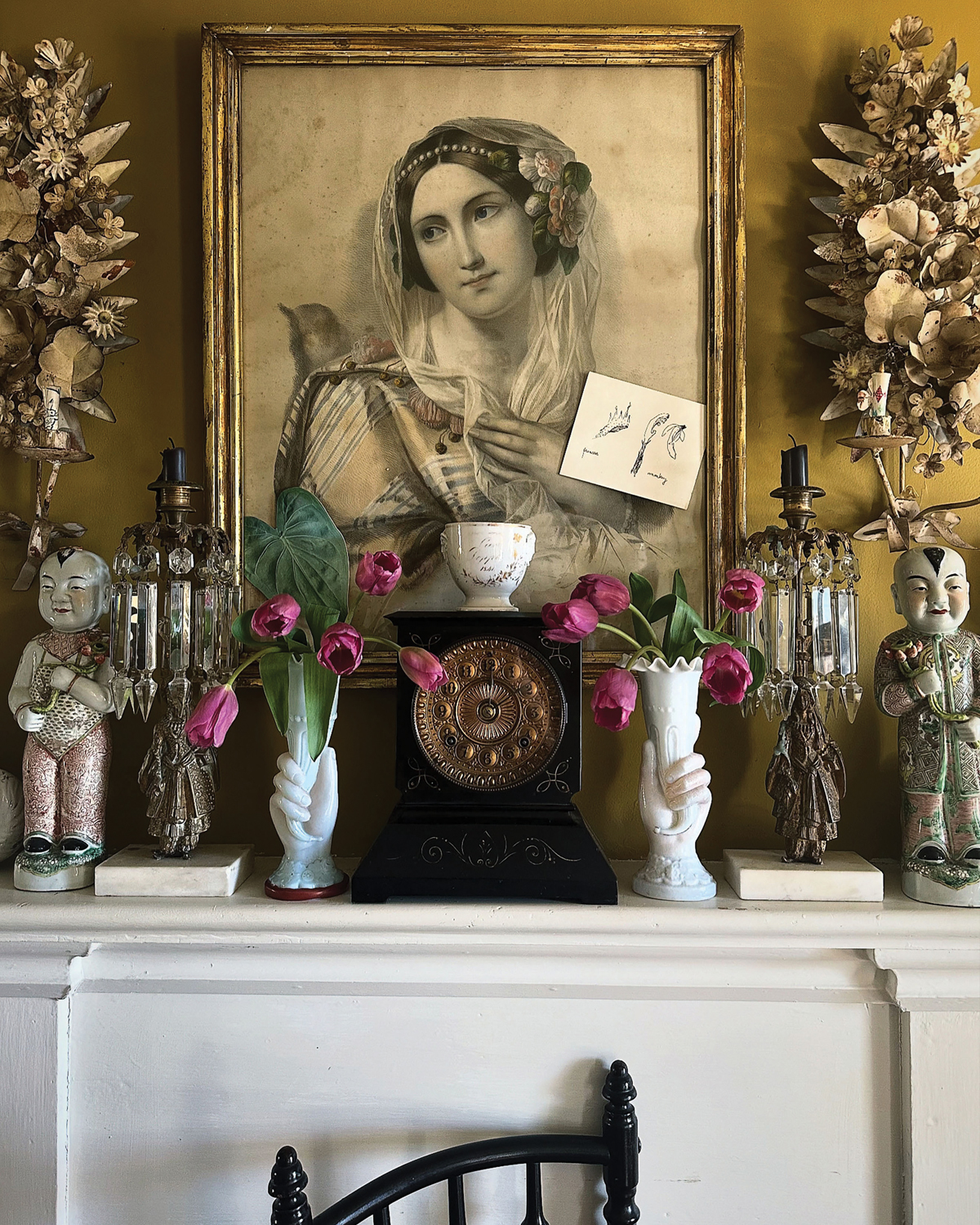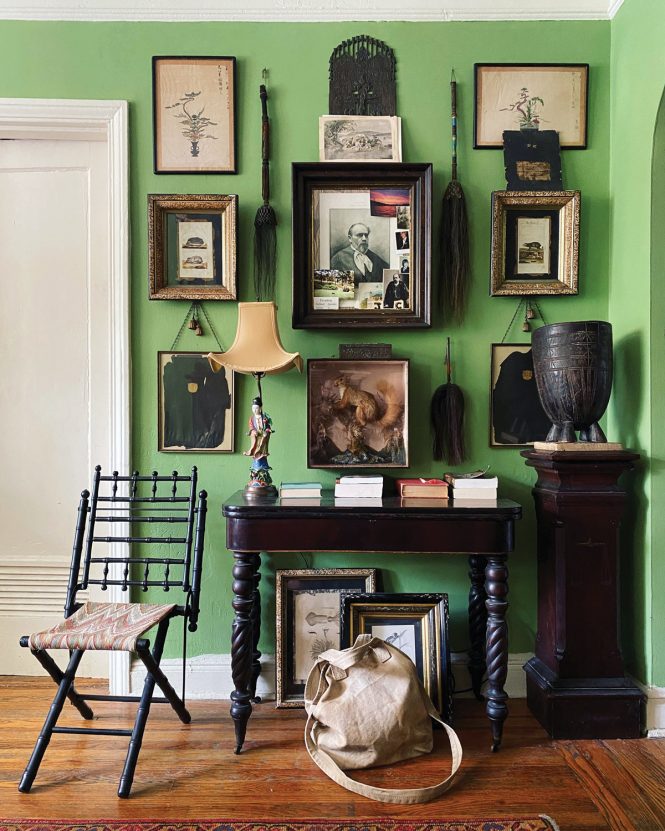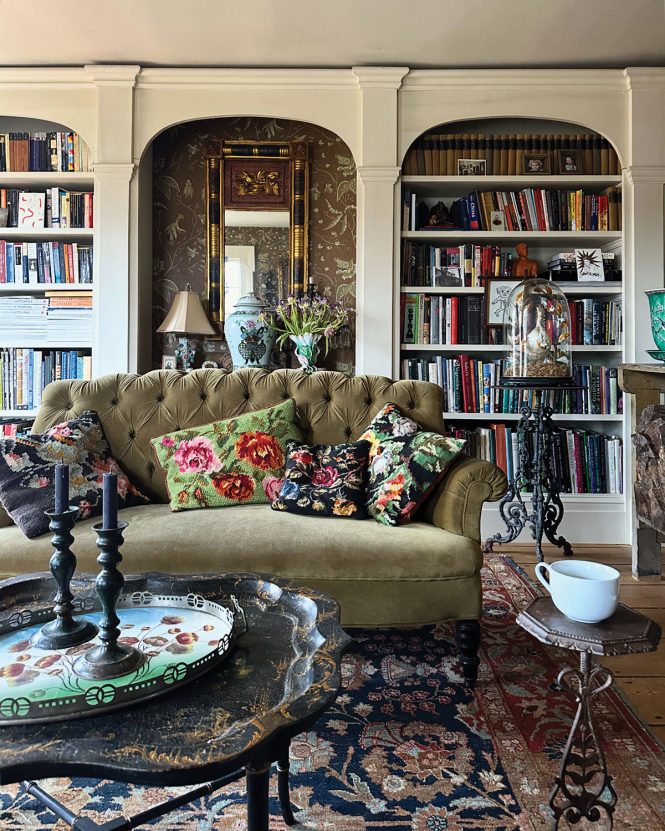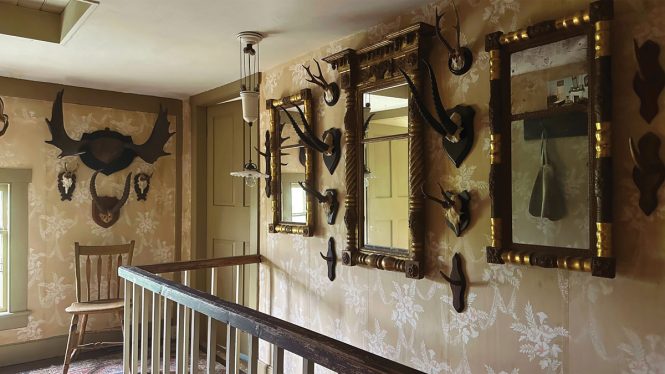Perfectly Imperfect: Treasure Hunting with James Coviello
By Hillary Harvey | Summer 2024 | Design Feature
It was among the corrugated market stalls towards the suburbs of Lima, Peru, where James Coviello found the anchor piece for his house in the Columbia County town of Taghkanic. The Shacks, as they’re called, were rumored to have been a fruit market, but were now home to antiques sellers and situated on the way to the airport. His colleague, who ran the factory where his fashion line was produced, insisted that they stop there on one of his many visits. The anchor piece was an 1890s gasolier—a gas-burning chandelier—that had been electrified at some point. Coviello had never seen anything like it—an object reimagined by different hands over time. It was unexpected and somehow perfectly summed up his historic house. He repacked his luggage right there in the stall, fit the antique body in, and carried the glass panes onto the plane. “I’ve collected a lot of objects in my life, but there are a few memorable ones that guided the decoration of this house,” Coviello says, “and also guided me toward exactly what I was looking for.”
That was over 20 years ago, and now, Coviello’s house is almost famous—featured in design magazines and from various vantage points on Coviello’s Instagram account, which has nearly 90,000 followers. The account also tracks Coviello’s interior design eye as he visits historic houses and museums and hunts for great objects around the Hudson Valley and beyond. In one post, a vase from Bangkok is pictured on a mantel next to a complementary one he found in a local shop. His collection of American empire mirrors in the hallway upstairs and the antique washstand in the bathroom were just reproduced in an Italian magazine. I ask Coviello what it is that makes his country home so appealing to others. “It’s livable in a way that’s unusual for people who collect antiques. I think it represents a casual way of living with antiques, rather than just making them precious,” he replies. “I love the saying, perfectly imperfect—that really sums up the way I live, and I think people can relate.”
Savvy Shopping
Coviello’s approach to interior design is to translate people’s personal style into an appropriate fit with the period and architecture of their house. He honed his skills of interpretation as a fashion designer when he worked with other designers to create accessories for their lines. “They would show me their collections and mood boards, and I would take their idea and make it into their dream accessory,” Coviello explains. “A client can come to me and say, ‘I don’t really know what I want to do, but I really love Shaker, and I really love clean lines, and I don’t really like fussy, but I like vintage.’ I’m good at putting that all together for them in a way that they couldn’t do themselves.” Coviello’s interior design style is to be a vehicle for good ideas, articulated through objects and placement, where the colors are soothing or a feast for the eye.

The arsenic green walls in Coviello’s Brooklyn Heights apartment are a custom color designed by him. The gallery wall features antique objects and ephemera collected from flea markets and antique shops across the world from China to Peru.
For those new to antiques collecting, Coviello recommends starting with elements you like that are similar. “For instance, let’s say you love Blue Willow China. Start acquiring a few pieces—maybe a couple of platters, a bowl, some plates. And then once this collection is together, you can display it on a wall,” Coviello suggests. “Then you have a vignette. I do that with my own decorating.” With interior design projects, it can start with a simple question. One client invited Coviello to their home in Connecticut for a consultation on paint colors, fixtures, and object ideas—a one-time engagement. Others hire him for full-scale home redesign.
Coviello is always shopping—because there’s always something just in, and he loves to make unexpected finds. Recently, in Hudson at Regan & Smith, he spied two glass lamps that stopped him in his tracks. He knew they would be perfect for a client’s home, but he had to know where to place them before recommending the client buy them. When he called back a couple days later, the lamps were gone. Coviello says every antiques person has a similar story. “I remember a bed I saw at a New York City flea market in 1995 that I still think about, like, that’s the bed that got away,” Coviello reminisces. “And it’s such a horrible feeling, but it’s also what makes it so exciting.”

The living room features a pair of 19th-century tufted sofas upholstered in moss green velvet. The bookcases were designed by Coviello, modeled after the Greek revival fireplace mantel millwork original to the house.
Coviello says he more often walks away, rather than impulse buying. He suggests taking pictures of interesting objects and, even if you’re standing in front of it for a while, don’t buy it without knowing where you’ll put it or what you’ll replace. This helps with both the budget and the clutter. After watching something for a while, and seeing it doesn’t get sold, you could swoop in six months or a year later to make an offer, and the dealers often want to just get it out of the shop at that point, so you can get a good deal.
In the Hudson Valley, Coviello’s favorites in Millerton are Cottage+Camp and Montage Antiques for treasure hunting, Upstate Rug Supply in Hudson for curated vintage carpeting, and Hudson Valley House Parts in Newburgh for architectural salvage—windows, doors, urns, gutters, and other decorative elements saved during a historic building demolition. For multi-dealer antiques shopping, Coviello recommends Berkshire Galleries, Milne Antiques in Kingston, and the Antique Warehouse in Hudson, where many of the storefronts on Warren Street migrated.

The upstairs stair hall is papered with wallpaper from the 1930s and is hung with a collection of gilded 19th-century American Empire-style mirrors. The vintage mounted horns were collected from Coviello’s travels in Europe and the UK.
A big part of what Coviello does is to restore objects. His studio in Hudson is full of antique furniture waiting to be reupholstered and placed in the right home. “I think people are afraid of antique furniture sometimes because they think it’s fragile, or if it’s lamps or lighting, that it’s not safe,” Coviello says. “I don’t just buy a piece of furniture at the flea market and put it in your house; I have a carpenter and an upholsterer and someone who makes slipcovers and a really great lamp person. It’s my team, my good eye, and then you get a quality piece of furniture, well placed, at the end of the day.”
